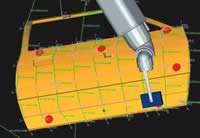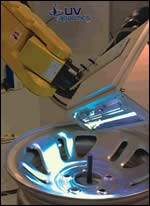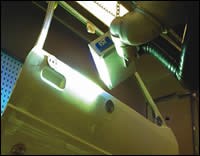Curing with a Twist
Adding robots to UV technology allows curing of complex 3-D parts.
#curing
Ultraviolet curing requires direct line-of-sight between the coating and the UV lamp source. This simple requirement frequently causes headaches for manufacturers who need to cure complex 3-D parts with recesses and curves. At the same time, with the rising popularity of UV technology, these parts are becoming more popular candidates for UV coating.
Even when parts have simple shapes, their sheer size can make curing them a challenge. That’s because many of the UV lamps that were developed for curing small and simple profiles like optical fibers or CD-ROMs just aren’t well suited to curing a car body, airplane fuselage or boat hull. At least not cost effectively.
Featured Content
Until recently, the answer has been to use a “bigger hammer:” more lamps, more power. A number of systems have been installed that use formidable banks of individual UV lamps to cure large or complex parts. Unfortunately, many other projects never even get off the ground because the capital investment required for large arrays of lamps is cost prohibitive.
While the idea of using a robot to move lamps has been tried for years, early attempts were disappointing for a number of technical reasons. Now, advances in robotic UV curing may finally provide a workable answer for curing these more challenging parts.
Advantages
Robotic UV curing appears to offer several potential benefits, ranging from lower capital cost to reduced operating and energy expenditures to the ability to provide 100% curing for a range of parts.
A single robotic UV lamp can often replace a large number of fixed lamps. Along with each fixed lamp are often a number of other capital costs, such as a power supply, blowers for cooling, lamp fixtures, power racks and wiring, safety equipment and, frequently, air filtration/conditioning equipment. For systems with many lamps, power transformers and other power handling equipment may be needed.
Operating expenses for a single lamp can be far lower than for an array. Bulbs, reflectors, magnetrons for microwave powered lamps and other parts have finite lifetimes. The cost of these replacement parts is magnified on multi-lamp systems—not to mention the time and labor cost needed to maintain the system.
Energy used to be something thought of as something that came out of the wall for free. Not any more. Even the smallest industrial UV lamps require several kilowatts of electricity each. Add to the lamp the additional cost of cooling air generation (which can be significant) and air make-up, and it’s easy to see that the fewer lamps, the greater energy savings.
Robotic curing can minimize “shadow areas”—a well-recognized problem for UV curing. An articulated lamp can reach any visible surface of the part. And with proper engineering and robot programming, every location on the part can receive exactly the same amount of UV energy.
Robotic lamps can be positioned at a constant distance even on parts with very complex geometry. The robot can move the lamp so that exposure time is identical for every spot on the part. In general terms, if it can be painted it can be cured using a robot approach.
The ability to move the lamp to accommodate any part configuration is another advantage of robotic UV curing. Using fixed-position, multi-lamp systems for a variety of parts always requires a compromise. Some parts are farther from the lamps, some are closer. This can cause uneven curing, which may lead to performance and even appearance concerns. This is especially important when the finish requires high UV intensity, or peak irradiance.
When UV chemists talk about lamps, there are three basic parameters that play an important role in how well a process works: wavelength, peak irradiance and dose, a measure of how much irradiance over time the coating experiences. A robot obviously can’t change the wavelength of the UV lamp, but it can provide a unique and optimized lamp configuration that assures the right combination of UV irradiance and dose for every part.
Robotic curing with a single lamp is also cleaner than multi-lamp setups. The extreme temperatures used in traditional mercury UV lamps require constant cooling. This cooling creates turbulence in the process zone, which can stir up dirt and other contaminants. For most cosmetic UV processes, even a small speck of dirt can mean scrap or rework.
A single robotic lamp creates far less disruption and opportunity for contamination. In fact, some robotic lamp designs utilize a fully enclosed cooling system where no cooling air is introduced to the curing chamber.
Application Example
Today’s automotive headlight lenses are nearly all supplied with a clear UV coating that provides scratch-resistant protection to the polycarbonate lens. One manufacturer of these parts currently uses a UV curing line outfitted with 12 fixed lamps—a common configuration for curing these parts.
This same part was cured by a single robotic curing cell in the same production time. The final cure was actually better with the robot, because it could apply UV to an edge of the part which couldn’t be fully cured on the fixed-lamp production line. And, while the coating manufacturer recommends 7-8 Joules of UV to achieve full curing, the robotic system required less than 3 Joules to accomplish full cure.
What accounts for this dramatic reduction in the amount of UV needed for cure? The robot’s ability to deliver UV exactly where it’s needed and to position the lamp close to the coating surface.
System Engineering
In the trade off between fixed lamps and robots, cycle time is often an important factor. In order to optimize cycle time, robotic lamps frequently move at a pretty good rate of speed, then change direction rapidly.
This means not all UV lamps are well-suited to robotic curing. In the most common medium-pressure mercury lamps, the plasma in the UV lamp consists mostly of vaporized mercury. Mercury vapor is dense, and the plasma actually gets thrown around inside the lamp like a kid on a carnival ride. This can cause instability in lamp output.
Testing of various popular lamp sources, including arc, microwave and solid-state (LED) types, revealed that this is more than just a theoretical concern. A logging radiometer was fixed to the lamp so it could continuously monitor the lamp's output as the lamp was moved. The robot then put each lamp through various routines including changes in speed, acceleration and direction. There were clear differences in the lamps’ ability to deliver consistent output.
Proper engineering is also needed to build a lamp that is mechanically robust enough to operate reliably with constant movement, acceleration and abrupt changes in direction that introduce vibration and stress. Of course there are other practical considerations: weight, interconnections, footprint, cooling, and safety are all factors in making a correct choice.
There are a number of alternatives when it comes to selecting a robot. The final choice depends on a number of factors such as payload (the weight of the UV lamp and associated equipment), speed, work envelope and orientation of the robot. In some instances the robot may be floor, wall or ceiling-mounted. The robot can be mounted on a seventh axis to accommodate tracking of larger, slow moving parts. Robot controllers have the ability to track parts as they move through the curing chamber.
Curing Validation
Creating an even UV pattern with light is a lot like creating even film thickness with a spray gun. Each lamp produces a unique pattern in space. The intensity of the lamp varies in every axis, so programming is essential to getting even curing without striping the part due to too little or too much UV exposure.
One difference between “spraying” with light and spraying with paint is that you can directly measure coating thickness anywhere on the part when you are done with actual painting. But how do you know how much light reached each part surface when there’s nothing left to measure when you are done?
Validation of proper robotic curing is as paramount to robotic UV curing as measuring film build is to painting. Without a quantitative understanding of UV exposure there is a great risk of working with a process which may result in poor coating appearance or performance.
One practice is to use electronic radiometers to measure the UV intensity on a part. New technology allows a large number of small radiometers to be positioned on critical surfaces. These are connected to a central data logging unit which simultaneously gathers data from each, the goal being to adjust the process until there is sufficient and uniform irradiance and dose at every sensor.
A new patent-pending technique developed by UV Robotics uses real-time infrared thermography to measure the heat generated by UV sources as they shine on the part. Nearly all UV lamps generate a good deal of heat as well as UV light. Ordinarily, this heat is just a nuisance, but for analytical purposes, the heat can be correlated mathematically to the lamp’s UV output to generate a complete, real-time irradiance picture of the cure process.
Off-line Simulation
Another similarity between painting and curing is the increasing use of off-line computer simulations to expedite process development.
By modifying software tools developed at FANUC America Corp. (Rochester Hills, MI) for robotic paint simulation, the Fanuc/UV Robotics team proved that curing simulation is also possible. Each lamp has a radiant profile much like a spray pattern. Just as paint simulations can help process engineers create a uniform film build by providing precise overlap of the spray patterns with an appropriate path, the computer simulates a uniform curing path.
Aside from providing better quality, the off-line simulations also allow engineers to make subtle changes to the path in order to reduce cure cycle time to improve productivity.
Robotic Curing Cells
Robotic curing combines several disciplines—UV lamps, robots, test and measurement techniques and a well-engineered robotic curing cell. Cell engineers must consider several important safety and reliability concerns.
Workers must be properly protected from the potential dangers of UV sources and from hazards associated with robots. Safety interlocks, light curtains, floor mats, etc. are used to protect operators. Equipment must also be designed to withstand the rigors of constant exposure to UV light and manufactured of materials that resist UV degradation.
To find out which approach might be best for your application, start in the lab. Laboratory verification provides an opportunity to produce parts using a variety of curing technologies and evaluate all the variables before committing to a production system. A well-equipped UV lab includes not only a range of lamps but the measuring equipment needed to document UV exposure anywhere (and everywhere) on complex and large parts.
RELATED CONTENT
-
Fundamentals of Liquid Coatings for Finishing Operations
Before liquid coatings are selected for the industrial finishing line, it is important to have a solid understanding of how a coating works.
-
Preventing Solvent Pop
Preventing solvent pop on an industrial paint line...
-
Dis-Charge Your Powder
A practical approach to managing electrostatic problems and hazards during powder coating





















